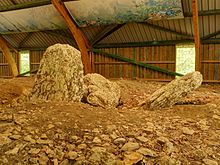Dolmen des Issières
The Neolithic Dolmen des Issières (also called Dolmen de Brévilliers) is located southeast of the village in the Bois des Issières (forest) near Brevilliers in the extreme east of the Haute-Saône department , in Franche-Comté in eastern France . It is one of 18 megalithic sites in the region and was examined in 1924 and excavated between 1976 and 1984. In France, dolmen is the generic term for megalithic structures of all kinds (see: French nomenclature ).
The dolmen, the majority of which is of the Schwörstadt type , shows some typical elements of the Aillevans type . It had an almost square chamber, which was accessed through a soul hole . The hill deprived of its Dolmen consisted of four major sidestones, a ceiling plate and two atypical for type Schworstadt transformants which form the lateral boundary for a kind of hall. The two limestone slabs belonging to a paved corridor are of poorer quality than those of the chamber and may have been added secondary. The east-facing dolmen has a total length of about five and a width of two meters. The chamber has an internal length of 1.4 m. The plan and dimensions are the results of the excavations. In the current state of the monument, it is difficult to see its shape, as only four of the seven stones that were once preserved have been collapsed. The height of the chamber was about 0.9 m.
The Dolmen des Issières was initially located in a round hill. As with the Dolmen of Aillevans, this hill was built over with a trapezoidal hill about 20.0 m long. Its nine meters wide, longer side formed the front of the dolmen. The system is now in a hall.
The complex is considered a creation of the Horgen culture , which was influenced by the Allée couvertes of the Seine-Oise-Marne area. The artifacts found consisted of diamond-shaped arrowheads and a flint dagger .
context
In the Jura arch , the megalithic systems can be divided into three groups:
- the Dolmen of the Schwörstadt type with a square chamber and a soul hole, located under a round mound of earth,
- the structurally identical dolmens of the Aesch type with a rectangular chamber,
- the Aillevans-type dolmens with a rectangular chamber and anteriorly or laterally protruding ante (so-called antenna dolmen ). The chamber can be surrounded by a round mound of earth or trapezoidal dry stone masonry.
The Auvernier Allée couverte may be of this type.
literature
- Urs Schwegler: Chronology and regionality of Neolithic collective graves in Europe and Switzerland. ISBN 978-3-9524542-0-62016
Web links
Coordinates: 47 ° 34 ′ 39.9 ″ N , 6 ° 48 ′ 2.2 ″ E
